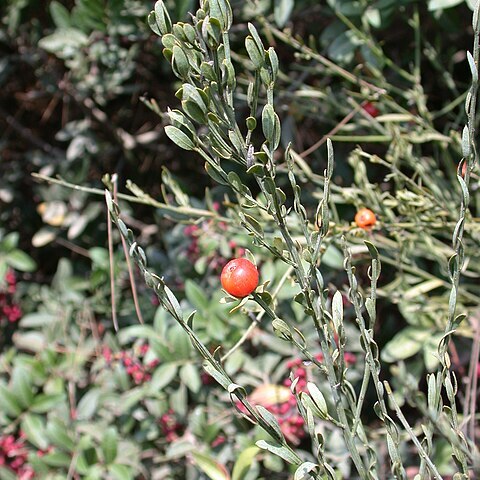Shrubs or small evergreen trees; branchlets ribbed by raised vascular strands running out into midribs of leaves, ultimate twiglets flattened. Leaves petiolate, opposite or alternate, penninerved, coriaceous, both surfaces minutely and closely white-dotted. Flowers hermaphrodite and male (plants androdioecious), axillary and terminal, either solitary or in 2–3-flowered dichasia or umbellate clusters, sometimes panicled; bracts and bracteoles very small, free from peduncle, soon deciduous. Perianth tube very short; lobes usually 3 or 4, valvate. Stamens normally 3 or 4, inserted at base of perianth lobes; anthers attached to lobes by tuft of hairs. Disk fleshy, lobed, lining inside of perianth tube. Ovary with 3–4 ovules pendent from apex of erect free-central placenta; stigma 3–4-lobed. Fruit indehiscent, ovoid, epicarp fleshy.
Flowers hermaphrodite and male (plants androdioecious), axillary and terminal, either solitary or in 2–3-flowered dichasia or umbellate clusters, sometimes panicled.
Shrubs or small trees; branchlets ribbed by raised vascular strands running out into midribs of leaves, ultimate twiglets flattened.
Leaves petiolate, opposite or alternate, penninerved, coriaceous, both surfaces minutely and closely white-dotted.
Stamens normally 3 or 4, inserted at base of lobes; anthers attached to lobes by tuft of hairs.
Ovary with 3–4 ovules pendant from apex of erect free-central placenta; stigma 3-or 4-lobed.
Bracts and bracteoles very small, free from peduncle, soon deciduous.
Perianth tube very short; lobes usually 3 or 4, valvate.
Disk fleshy, lobed, lining inside of perianth tube.
Fruit indehiscent, ovoid, epicarp fleshy.

